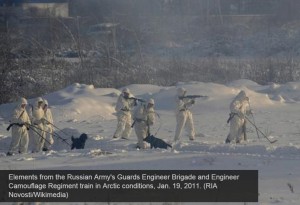 Although the crisis in Ukraine continues to focus attention on Russia’s western border, Moscow is seeking to exploit a more lucrative prize along its vast northern frontage: the Arctic Circle. Melting ice has opened up new transit routes and revealed previously inaccessible oil and mineral deposits. Facing a year of harsh economic constraints, securing exploitable energy reserves remains a top priority for Moscow. The planned militarization of the Arctic is already underway, and funding is secured through 2015 (the Ministry of Defense was the only Kremlin ministry not to be curtailed in the most recent budget.) With Russia aiming to consolidate its strength by the end of the year, surrounding countries are already reassessing their positions in the face of an overwhelming regional force.
Although the crisis in Ukraine continues to focus attention on Russia’s western border, Moscow is seeking to exploit a more lucrative prize along its vast northern frontage: the Arctic Circle. Melting ice has opened up new transit routes and revealed previously inaccessible oil and mineral deposits. Facing a year of harsh economic constraints, securing exploitable energy reserves remains a top priority for Moscow. The planned militarization of the Arctic is already underway, and funding is secured through 2015 (the Ministry of Defense was the only Kremlin ministry not to be curtailed in the most recent budget.) With Russia aiming to consolidate its strength by the end of the year, surrounding countries are already reassessing their positions in the face of an overwhelming regional force.
Russia’s traditional view of the outside world is colored by a deep sense of insecurity and paranoia. This is best exemplified by the events in Ukraine, where the Kremlin acted to preserve its traditional geographic bulwark against the West. This pattern of protectionism is also apparent in Moscow’s current understanding and approach to the situation in the Arctic. Of the eight countries of the Arctic Council, five are members of NATO, fueling Russia’s suspicion that opposing forces are massing against it. Although friction with Kiev and the West has overshadowed Russia’s military build-up in the Arctic, Moscow’s long-term ambitions for the region are making other Arctic countries nervous, Norway in particular.
Russia is interested in the Arctic for a number of reasons, though natural resources and pure geopolitical imperatives are the major driving forces behind Moscow’s thinking. The Arctic contains an estimated 30 percent of the world’s undiscovered natural gas and 13 percent of its undiscovered oil reserves, regarded by Moscow as important sources of foreign investment that are critical to the country’s economic development. The Northern Sea Route from East Asia to Europe via the Arctic Ocean provides another economic opportunity for developing infrastructure in northern Russia.
These resources and transit lanes, however, are also attractive to other Arctic countries, potentially turning the region into a political battleground. The U.N. Convention on the Law of the Sea regulates ownership of the Arctic, allowing for exclusive economic zones stretching 200 miles from land and even further if undersea resources sit on a continental shelf. Inhospitable conditions made previous boundary disputes futile, so the Arctic interior remains open to territorial claims and disputes. The interest expressed by other countries feeds Russia’s determination to make its role as a central Arctic nation clear by any means possible, including the use of military pressure.
Russia’s Arctic Build-Up
Militarizing the Arctic will be a key imperative for the Russian military throughout 2015 and beyond — alongside modernization in general and bolstering forces in Crimea and the Kaliningrad exclave. According to the Russian Ministry of Defense, Soviet-era bases in the Arctic are being reactivated in response to NATO’s renewed interest in the region. The airstrip on the archipelago of Novaya Zemlya is being renovated to accommodate modern and next generation fighter aircraft in addition to advanced S400 air defense systems. Part of the Northern Fleet will also be based on the island chain, which is ideally positioned for operations in the Arctic region. The Northern Fleet represents two-thirds of the entire Russian Navy, which is the only navy in the world to operate nuclear-powered icebreaker ships. In addition, Moscow announced the formation of a new 6,000-soldier military group in the far north consisting of two motorized infantry brigades located in the Murmansk area and the Yamal-Nenets autonomous region. Radar and ground guidance systems are also planned for Franz Josef Land (part of Novaya Zemlya), Wrangel Island and Cape Schmidt. The Federal Security Service plans to increase the number of border guards on Russia’s northern perimeter as well.
The recent Vostok 2014 full-scale military exercise — the biggest since the collapse of the Soviet Union — was a revealing indication of Russia’s intentions in the Arctic. Russian troops, sailors and airmen carried out combat training missions in the region, prominently deploying Pantsir-S (air defense) and Iskander-M (theater ballistic missile) weapon systems, among others. Such activities inevitably evoke the atmosphere of the Cold War, when the region was the focus of U.S. and NATO attention. Furthermore, Russia’s Northern Fleet announced that its Independent Marine Infantry Brigade will undergo intensive training in the Arctic region throughout 2015.

